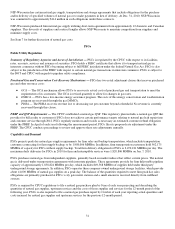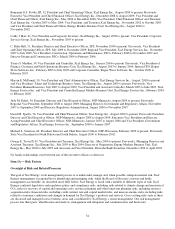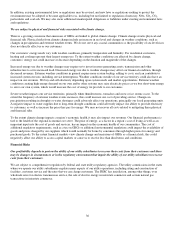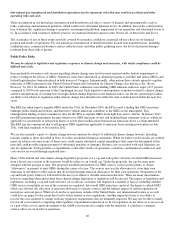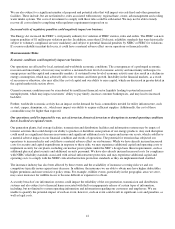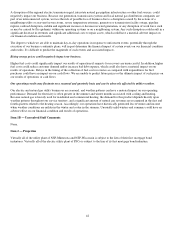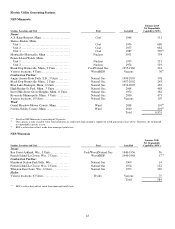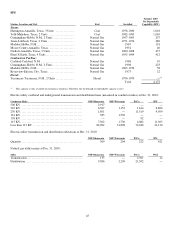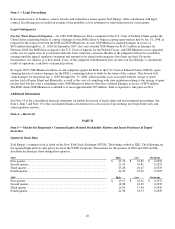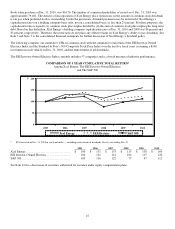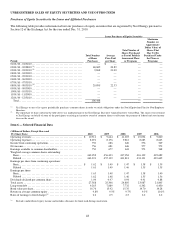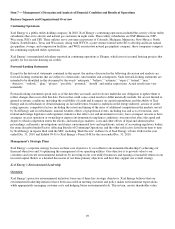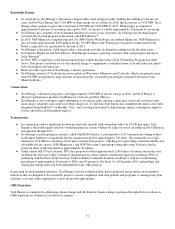Xcel Energy 2010 Annual Report Download - page 51
Download and view the complete annual report
Please find page 51 of the 2010 Xcel Energy annual report below. You can navigate through the pages in the report by either clicking on the pages listed below, or by using the keyword search tool below to find specific information within the annual report.41
We are also subject to a significant number of proposed and potential rules that will impact our coal-fired and other generation
facilities. These include, but are not limited to, rules associated with mercury, regional haze, ozone, ash management and cooling
water intake systems. The costs of investment to comply with these rules could be substantial. We may not be able to timely
recover all costs related to complying with regulatory requirements imposed on us.
Increased risks of regulatory penalties could negatively impact our business.
The Energy Act increased the FERC’s civil penalty authority for violation of FERC statutes, rules and orders. The FERC can now
impose penalties of $1 million per violation per day. In addition, more than 120 electric reliability standards that were historically
subject to voluntary compliance are now mandatory and subject to potential financial penalties by NERC or FERC for violations.
If a serious reliability incident did occur, it could have a material adverse effect on our operations or financial results.
Macroeconomic Risks
Economic conditions could negatively impact our business.
Our operations are affected by local, national and worldwide economic conditions. The consequences of a prolonged economic
recession and uncertainty of recovery may result in a sustained lower level of economic activity and uncertainty with respect to
energy prices and the capital and commodity markets. A sustained lower level of economic activity may also result in a decline in
energy consumption, which may adversely affect our revenues and future growth. Instability in the financial markets, as a result
of recession or otherwise, also may affect the cost of capital and our ability to raise capital, which are discussed in greater detail in
the capital market risk section above.
Current economic conditions may be exacerbated by insufficient financial sector liquidity leading to potential increased
unemployment, which may impact customers’ ability to pay timely, increase customer bankruptcies, and may lead to increased
bad debt.
Further, worldwide economic activity has an impact on the demand for basic commodities needed for utility infrastructure, such
as steel, copper, aluminum, etc., which may impact our ability to acquire sufficient supplies. Additionally, the cost of those
commodities may be higher than expected.
Our operations could be impacted by war, acts of terrorism, threats of terrorism or disruptions in normal operating conditions
due to localized or regional events.
Our generation plants, fuel storage facilities, transmission and distribution facilities and information systems may be targets of
terrorist activities that could disrupt our ability to produce or distribute some portion of our energy products. Any such disruption
could result in a significant decrease in revenues and significant additional costs to repair and insure our assets, which could have
a material adverse impact on our financial condition and results of operations. The potential for terrorism has subjected our
operations to increased risks and could have a material adverse effect on our business. While we have already incurred increased
costs for security and capital expenditures in response to these risks, we may experience additional capital and operating costs to
implement security for our plants, including our nuclear power plants under the NRC’s design basis threat requirements, such as
additional physical plant security and additional security personnel. We have also already incurred increased costs for compliance
with NERC reliability standards associated with critical infrastructure protection, and may experience additional capital and
operating costs to comply with the NERC critical infrastructure protection standards as they are implemented and clarified.
The insurance industry has also been affected by these events and the availability of insurance covering risks we and our
competitors typically insure against may decrease. In addition, the insurance we are able to obtain may have higher deductibles,
higher premiums and more restrictive policy terms. For example, wildfire events, particularly in the geographic areas we serve,
may cause insurance for wildfire losses to become difficult or expensive to obtain.
A security breach of our information systems could impact the reliability of the our generation, transmission and distribution
systems and also subject us to financial harm associated with theft or inappropriate release of certain types of information,
including, but not limited to system operating information and information regarding our customers and employees. We are
unable to quantify the potential impact of such an event, however, such an event could result in significant costs and penalties, as
well as legal costs.


